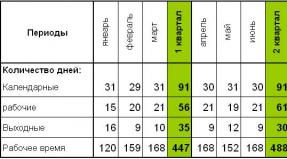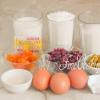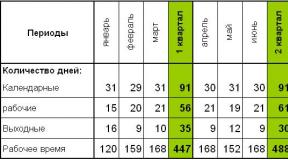Optimal arrangement of beds in a greenhouse. Correct beds in a greenhouse: sizes, what to make, how to arrange. Master class: making high greenhouse beds
Arranging a greenhouse on the site allows you to provide yourself with an early harvest of vegetables and herbs. The most popular models include polycarbonate greenhouses with an area of 3x6 m. Proper placement of beds in them is the key to effective use of greenhouse space. This article with photos and videos will tell you in more detail about what beds there are and how to make them in a greenhouse measuring 3x6 m.
While still at the stage of choosing a location for a future greenhouse, you should think through and take into account several important points:
- location of cardinal directions;
- placement of communications;
- bed model.

Greenhouses measuring 3 by 6 are the most popular among gardeners
The location of the greenhouse relative to the cardinal points plays a significant role in the choice of plants cultivated in it. Traditionally, beds are placed along long walls. If you plan to grow low-growing crops in the greenhouse, then its location in the north-south direction will allow the grown crops to receive maximum sunlight. When planning to cultivate tall plants, it is better to place the greenhouse in the east-west direction, so the sun's rays will easily penetrate between the plants, illuminating them evenly.
Attention! If the area allocated for the construction of the greenhouse has a slope, then it is better to turn it to the south.
The site for the greenhouse should be open, not shaded by other buildings or trees, and have a convenient approach. If it is impossible to locate the greenhouse in accordance with the recommended cardinal directions, it should be arranged in such a way that the greenhouse space is maximally illuminated in the first half of the day. If the greenhouse is lit only in the afternoon, this will significantly affect the yield of the crops grown. When setting up a greenhouse, it is equally important to arrange communications so that its watering and heating are uniform.

Options for arranging beds in a greenhouse
Models of beds for arrangement in a greenhouse
The conditions of a greenhouse with an area of 3x6 m allow you to arrange several options for beds:

Attention! Vertical, stepped and hanging beds allow efficient use of greenhouse space, but require additional lighting and more frequent watering and fertilizing.

The beds in the greenhouse can be made warm
Possible schemes for organizing beds in a greenhouse
When setting up a greenhouse measuring 3x6 m, the beds can be conveniently arranged using one of the options, the main thing is not to save space on the aisles:
1. 2 longitudinal beds under walls, each 0.9 m wide, + central passage – 1.2 cm. Planting in such beds is done using the two-row or square-cluster method.
Attention! The beds should not be made wider than 1.2 m, otherwise they will be difficult to care for. The best guide when choosing the width of the bed is your own height and the amount of effort that will be required to cultivate it.

Two longitudinal beds are the most popular option in 3 by 6 greenhouses
2. 2 side and 1 central beds, each 60 cm wide, aisles between rows - 60 cm. In such beds, seedlings are planted in a checkerboard pattern or in 1-2 lines.
3. 2 narrow side beds about 50 cm in size + a central bed 1 m wide and 2 passes of 50 cm each. Planting in such beds is done using a square-cluster or single-row method.
4. A narrow bed around the entire perimeter of the room 45 cm wide and a central bed 1-1.1 m wide + 50 cm aisles. On narrow beds, vegetable seedlings are planted in 1 row or nesting method, and on a wide central bed - in 2 rows or nesting method in a checkerboard pattern. If desired, the bed located in the center of the greenhouse, as well as along the blank end wall, can be replaced with a rack or table on which boxes with seedlings and vegetables grown in containers can be compactly placed. When using racks for growing seedlings, it should be noted that their depth should not exceed 50 cm. Under this condition, the shelves will minimally shade the plants placed below.

If the crops in the greenhouse do not grow. three beds can be made, but narrower
Attention! When planning the layout of the beds, you should take into account the requirements for the microclimate of the crops grown in the greenhouse. Crops that require different conditions should be placed at opposite ends of the greenhouse; if desired, they can be separated with a film curtain.
A variety of bed arrangement options makes it easy to select the most convenient model depending on the crops being cultivated and obtain high yields. By taking into account the recommendations for arranging the selected model of beds in a polycarbonate greenhouse measuring 3x6 m, you can achieve the most efficient use of greenhouse space.
Organizing beds in a greenhouse - video
Beds in a greenhouse 3 by 6 - photo






You can form 2-3 ridges in the greenhouse, it depends on the volume of the greenhouse. The maximum width of the bed is 120 cm, then you can easily care for crops without leaving the path. You need to make them the height that is most convenient for you: if you can reach a meter with a hoe, then build a meter-long bed.
Arrangement of beds in the greenhouse
To the cardinal points
It is considered a tradition to place them, focusing on the cardinal directions.
Most often, the ridges are located in the direction from north to south, but this may not be suitable for every vegetable plant.
For crops grown in a greenhouse, the best placement of the beds will be from west to east. In this direction, crops receive maximum sun exposure from sunrise to sunset.
Because if the sun shines on greenhouse crops only in the afternoon, the yield is greatly reduced.
By type of crop
If you have an uneven plot, then you need to lay the ridge on the south side and perpendicular to the slope. Then the ridges will be at different heights to one another, and the crops will be illuminated as much as possible by the sun's rays.
Methods for creating beds are also selected based on the type of plants. For example, for seedlings that grow in pots, you can make several shelves standing at different heights near the walls of the greenhouse. Then you can not only place the crops in a better place, but also, as they grow, move them to another place. Tall plants (cucumbers, tomatoes, etc.) are grown exclusively in soil beds.
Types of beds
- Terrace beds. They are made if there are slopes on the dacha plot of land. The basic order is that one type of crop is planted on one terrace.
- Pyramid. This bookmark saves space. To build it, you need to take several boxes and a pipe; it needs to be dug into the ground. Then they put boxes on the pipe and pour soil into them. It is recommended to plant strawberries, lettuce, cilantro, and parsley there. You can also make an irrigation system if you make holes at a certain level.
- Vertical. They will come in handy if you are short on space. Strawberries and pumpkin plants are placed in them. Their main advantage is that vegetables and berries do not rot due to the fact that they do not come into contact with the ground.
- French. This is a circle divided into triangles. Various crops are planted in the ridges. They are:
- raised to any height;
- located flush with the ground surface. Metal, stone or wood borders are made for them.
- Bosquet beds. This is one of the types of French ridge. Low-growing crops are planted in them. They can be of various shapes.
 Beds made from boxes according to Mittleider
Beds made from boxes according to Mittleider In narrow open beds, crops are planted very densely. They can be:
- from wooden boxes;
- dug in the ground.
Beds made from boxes
Take wooden boxes 35-150 cm in diameter and put soil in them. First you need to mark the boards. Then the boards are knocked together along the frame and installed according to the markings.
It is recommended to place agrofibre at the bottom of the boxes and add soil.
They tend to be warmer and are good for early crops. Geofabric is laid on the bottom of the bed, then sand, tops, hay, rags, papers, peat soil and garden soil, and humus are poured. At the end, pour hot water and cover with plastic wrap.

What mixture do you fill the beds with?
Don’t forget, everything you bring in will be compacted 2 times. You can fill it with branches, wood chips and 2 layers of soil with peat soil. Then you will separate the fertile soil and the cold soil.
If you place plastic bottles at the very bottom, tightly closed with lids, they will retain heat perfectly.
Branches are placed on top of them and cardboard is laid.
Step-by-step instruction:
- Using a laser level, place the paving slabs on the ground. Place 2 layers of roofing felt on them for thermal insulation.
- Assemble the frames. Use timber 600x150x100 mm and metal fittings: corners 200x100 mm and plates 200x80 mm. Treat the wood twice with Senezh-Bio. Install fastenings for the arches. It’s good to take plumbing ones with a diameter of 3.2 cm, but you need to drill one hole in them from the top with a diameter of 4 mm, retreating 100 mm from the edge.
- Place non-woven material. It is best to use Dornit, which has a density of 150. It is attached to the frame with a construction stapler, but lay it with some sagging, then it will not tear from the poured earth.
- Place the arcs. It is best to use polypropylene pipes with a diameter of 2 cm. If you need to make them longer, then take adapters made of polyvinyl chloride. If the pipes and adapters have the same diameters, then increase the adapters by lowering each adapter halfway into boiling water for a minute.
- Remove from the water and carefully screw from the required side into the polypropylene pipe until the adapter has cooled. Once everything has cooled, you will have a strong connection. And insert polypropylene pipes into the supports until they stop.
- Secure the top of the arch support, then in the wind they will not tilt in different directions. Place a central steel arc - a rod with a diameter of 1 cm.
- Fill the ridge. Place 10 cm of soil after the cardboard, which was previously poked with a pitchfork. Next, add tops, hay and a mixture of 1 part sand, 3 parts turf soil, and mineral fertilizers.
- Cover the greenhouses. It is advised to take snow-white “Agrofibre”, which has a density of 60, and attach it with clamps that have a green tint on the steel rod and a black tint on the polypropylene pipes.
Warm beds
The base for them is created from a pile of waste; it will rot for a long time. To keep them saturated with moisture, it is necessary to water each layer abundantly. If you plant plants this way every year, you don’t have to make a compost heap, because rotted organic waste serves as compost.
 Filling warm beds for a greenhouse
Filling warm beds for a greenhouse Step-by-step instruction:
- Dig a trench to a depth of about 50 cm or more, 120 cm wide. Select the length yourself.
- Then place a metal mesh with small cells at the bottom to protect the plants from damage by rodents.
- Next add scalded sawdust. Moisten them thoroughly with a solution of potassium permanganate. Sprinkle fertilizer on top. Sprinkle each layer with sand and soil and compact it. The height of one layer is 15 cm. The last layers are fallen leaves, mowed plants, tops, compost.
- At the end you need to add: 1 bucket of sand, 1 bucket of scalded sawdust, 6 buckets of peat or regular soil, 1 tbsp. l. ash, superphosphate, potassium sulfate, zinc sulfate, sodium tetraborate and urea. This layer is made 15 cm thick so that the rhizomes of the crops do not penetrate the grass.
- The bed needs to be watered generously. You can add impurities: Baikal-M or Siyanie.
Today there are different types of greenhouses. The location of the beds and their configuration depends on the type of structure. Plants for planting are also selected taking into account the type of greenhouse. If, then the owner can start growing any crops.
Simple options for planning beds in a greenhouse measuring 3x4 meters
Types of greenhouses:
- Gable;
- Arched;
- With a geodesic dome.
The first option is ideal for growing trees that will be surrounded by warm air. For seedlings such a structure is considered less suitable. For plant beds, it is better to choose other options. These greenhouse designs are not very tall and provide the gardener with plenty of space. An example of optimal dimensions is 3x6 m, and suitable materials are polycarbonate sheets.
The layout of the beds must be done correctly. If you make them wide, the harvest may suffer. To reach the plant, you will have to step on the bed.

Arranging beds in a 3x6 polycarbonate greenhouse
And this will entail undesirable consequences: you can damage the root system or compact the soil. When roots develop slowly due to mechanical damage or reduced permeability of the soil, the plant will produce less fruit. It all depends on which method you prefer. Make the width of the beds no more than 90–95 cm if you plan to grow plants on racks. When planted directly in open ground, the maximum width can reach 1.2 m.
The size of the passage must be wide enough so that you can move freely in it:

Increasing the area for the growing area
Allows you to distribute space with maximum benefit. Often, summer residents create more beds with the maximum possible width by reducing the size of the passage.
For example, they often make 3 beds, where the width is 1.2 m, and 2 passes of 30 cm each.
Experienced gardeners have their own trick on how to avoid stepping on crops. Concrete blocks are placed on the beds and in the aisle, and wooden boards are placed on top of them. Thanks to this design, you can reach any plant.
Layout of beds in a greenhouse with a geodome
The layout of a geodesic greenhouse has a number of significant differences:

The geodome is usually made of polycarbonate. The material is not as transparent as glass, but it is durable and has the ability to retain heat. A solar battery on the surface of the polycarbonate allows you to maintain the desired temperature inside. It is located at the top of the dome.
Mitlider greenhouse layout
An interesting solution for planning is the arrangement of beds proposed by the Canadian doctor Mittleider. He carried out the experiment for 50 years. As a result, the Canadian scientist made conclusions regarding the optimal sizes:
- the bed should be 45 cm;
- the passage should be left at least 90 cm.
This planting allows you to provide the most comfortable conditions for plantings. Plants are well ventilated. Each of them receives a sufficient amount of sunlight. Such conditions are most favorable for the development and growth of plants.
To set up such a greenhouse, you will need to get a compass. The location of the beds should be in the north-south direction. Make sure the soil surface is horizontal. The high yield is due to the use of balanced fertilizers. 
Timely watering is considered an important factor. And loosening the soil is not required.
The doctor gives recommendations for creating beds on any terrain. If the soil is poor for cultivation, then large boxes with a width of 1.2 m - 1.5 m and a height of 40 cm should be installed inside the greenhouse.
Prepared soil is poured into the boxes. These ridges are perfectly warmed by the sun's rays, and pests do not infest the plantings. However, plants require increased watering. If you agree with the doctor’s opinion, build your own Mitlider greenhouse from polycarbonate.
Features of a warm bed
Many gardeners are accustomed to surprising others with their achievements. Their harvest of zucchini the size of a good wild boar cannot go unnoticed. Other vegetables also grow better than others. The secret is quite simple. Summer residents plant their crops in compost or warm beds.

Diagram of the device with the dimensions of the warm bed
Productivity increases, and the soil does not need to be plowed. During the decay of organic matter, heat is released, which warms the soil well.
Carbon dioxide accumulates above the compost layer, which is involved in the process of photosynthesis. This promotes rapid plant growth. The temperature inside warm beds is higher than the surrounding soil. This allows you to plant early seedlings. The period of growth and fruiting of plants increases.
The warm bed is arranged as follows:

If there is no manure, then a thermal cushion is made in the following way:

Alternative methods of fencing for garden beds
Polycarbonate sheets are the same popular building materials for greenhouses as boards are for fencing garden beds. In addition to wood, alternative options can be used:

Build a greenhouse and do the right thing. Then each bed will delight you with its rich harvest. Make the conditions in the greenhouse favorable for plant growth. Arrange warm beds. And harvest several crops per season.
The presence of a greenhouse at your dacha significantly speeds up the appearance of early vegetables and fresh herbs on the dinner table, allows you to grow strong and healthy seedlings, and opens up new opportunities for the propagation of flower and ornamental crops and berries.
The area of the greenhouse always seems insufficient, and summer residents try in every possible way to adapt every free square. However, when wanting to place as many plants as possible in the greenhouse, we must not forget about maintaining a favorable microclimate.
The location of the beds in the greenhouse and their sizes should be selected not only from the point of view of rationality, but also taking into account the comfort for the plants. By leaving narrow paths between the beds, you will not only make it more difficult for yourself to care for the plants in the future, but also create conditions for the development of diseases characteristic of dense plantings with poor air circulation.
A greenhouse made of polycarbonate transmits solar energy well for the full growth of plants and the formation of a high-quality harvest, but only if it is correctly located in an open area. Unfortunately, it is difficult to achieve ideal conditions in a garden plot, since in addition to the greenhouse there are other buildings and plantings that create a certain amount of shading. To minimize the negative effect of this factor, it is necessary to choose the correct orientation of future ridges, in which all plants will be under the sun either throughout the day or only in the first half.
The traditional orientation of the beds assumes a direction from north to south. This arrangement is suitable for most low-growing vegetable crops (seedlings, peppers, eggplants, bush tomatoes, greens). But for uniform illumination of tall plants (including cucumbers and tomatoes on a trellis), it is recommended to place the beds from west to east.
Before installing the frame, it is necessary to determine how best to arrange the beds in the greenhouse and what type they will be (in country gardening, the most common are ground-based, table-top, and tall in the form of boxes).
Ground beds are simple and easy to set up, but it is difficult to create optimal conditions for the development of the root system.
Tabletop ones are convenient for daily plant care and are ideal for growing seedlings, radishes and herbs that require a lot of sunlight.

Raised beds are the most common and versatile. They warm up quickly, it is easy to change and disinfect the soil in them, and the maintenance of paths in the greenhouse, which can be tiled or concreted, is also simplified.

But from a phytosanitary point of view, it is undesirable to sow paths with lawn grass, as this will increase the humidity in the greenhouse and make it difficult to remove plant debris on which pathogenic microorganisms can develop.

Schemes for placing beds depending on the type of greenhouse structure and its size
The number of beds and their location are determined by the design features of the greenhouse. In a greenhouse less than 3 meters wide, it is more convenient to place the beds along the edges, leaving a wide passage. For larger greenhouses, it is rational to make two aisles and a third bed in the center.
The arched polycarbonate greenhouse has the largest usable area, in which plants in all beds receive optimal lighting, and the low height allows for good heat retention.
In gable greenhouses, good conditions are created for tall, cold-resistant plants, which can be placed around the perimeter, freeing up space for passages along the edges, and only the central bed, where the air is warmer, can be occupied by low-growing vegetable crops. A lean-to greenhouse is more often found as an extension to the wall of a house and serves to create a winter garden, so it is dominated by shelving and hanging baskets.

Beds in a greenhouse 3 meters wide can be made 65 cm each, which will provide two comfortable spacious passages, and all the plants in the beds will be freely accessible.

For greenhouses with a width of 2.5 meters, the beds will have to be made 90 cm each, which will somewhat complicate caring for plants and harvesting. If necessary, such beds can be divided into narrow transverse paths for passage.

The presented scheme is basic; other schemes of beds in a greenhouse are also possible with minor changes. It should be noted that the optimal width of beds in a greenhouse is determined not only by ease of care and maximum use of space, but also by the type of plants grown.

For example, beds for cucumbers may be narrower, since the plants grow along a trellis. In greenhouses with a width of 3 meters or more, two side beds can be made 45 cm each (the optimal width for two-row planting of vegetables), and the central one - about a meter, since access to the plants will be possible from both sides.

The rectangular base of greenhouses is most practical when the entrance door is located on the short side. In this case, you get long beds that can be divided for planting different crops. Thus, planting patterns in a 3x4, 6x3 and 3x8 greenhouse will differ only in the length of the beds.
The ideal width of the central path is 50 cm, which will allow you to use a garden wheelbarrow in the greenhouse. If there is no need for partial mechanization of the work, then the passage can be reduced to 30 cm.
Making raised beds with your own hands
As already noted, high and warm beds are the optimal solution for a high yield of greenhouse plants. In gardening stores you can purchase ready-made collapsible galvanized boxes. But it won’t be difficult to make beds with your own hands.

Bricks, metal and polycarbonate sheets, and boards are used to construct the sides. Some gardeners prefer extraordinary solutions in the form of pieces of slate and plastic bottles. In any case, there is no ideal material, so everyone chooses the simplest and most affordable option for themselves.
It is advisable to make high beds warm. You can arrange warm beds in the following way. At the site of the future bed, a frame (box) of a bed 0.5 m high is installed. The bottom is filled with rotten wood and branches (or straw and sawdust), then a mixture of sand and peat is filled in and dry horse manure is laid on top. Each layer is poured with boiling water and urea. The topmost layer consists of humus or compost. Only the nutrient layer and manure must be replaced annually.

Some summer residents arrange artificial heating in their greenhouses using hot water or electricity. Such technologies make it possible to obtain early harvests even in the conditions of the Far East and Siberia.

The height of the ridges can vary from 20 to 50 cm, although the optimal height of the sides is 40 cm (according to Mittleider). When constructing high beds, it is necessary to take into account the rapid drying out of the soil and consider a method for quick and effective watering (ideally an automated drip irrigation system).

To obtain a good harvest in limited greenhouse conditions, you need to take into account the environmental characteristics of the crops grown. So, beds for tomatoes are well suited for adjacent parsley, but are contraindicated for peppers and eggplants. Cucumbers go well with beans.
The recommendations presented will help you properly make beds in a greenhouse to obtain an early and high harvest. Setting up garden beds with your own hands is not difficult, as long as you plan everything in advance, even before purchasing the greenhouse itself.
Maintaining a greenhouse is not as easy as it might seem at first glance. Warm beds are those that are made correctly, arranged on the sunny side of the greenhouse, and also have certain layers that affect the warming of the soil. Depending on what types of filler will be used, a certain technology is required. That is why you need to approach this issue correctly.
It is important to think about the beds even before the greenhouse is installed. Since it must be correctly located, and experts believe that it is worth choosing a place according to the cardinal directions. This can affect how much light the green parts of the plants receive while growing. The shape of the beds can be very different.

For example:
- Oval;
- Square;
- Triangular.
As a rule, the installation of a new bed is carried out at the dacha from south to north. This option is suitable for all crops and even tall ones. The location of low-growing plants is best done from west to east. If the ground on the site is uneven, then you need to take a landmark to the south side, and organize the plantings perpendicular to the slope.
How to arrange beds in a greenhouse in width
The greenhouse can be installed with your own hands.

Moreover, it can be made from:
- Flat board type;
- Prefabricated metal structures;
- A material such as covering polycarbonate.
It is important to first decide what width the beds should be. To make them comfortable, the device must be made 90 cm wide. If the greenhouse is too narrow, then it is permissible to choose a width of 45-50 cm; some prefer to make beds 45 cm wide at the edges and an additional one in the middle.
If the roof is of a gable type, then you need to make landings in the middle, and leave passages along the walls. The width of the bed should be 150 cm.
It is important to make the right not only beds, but also aisles. The ideal option would be 50 cm, which is enough to place a bucket, basin or stand to sit down and improve the beds. Many people prefer to make beds according to Mitlider (photos and videos are in the public domain). The method has been tested for years, and the experiment lasted almost 50 years. According to the method, you need to make beds 45 cm wide and 90 cm wide, which will give the plants the maximum amount of lighting and enough air. In this case, plantings should be done from north to south. The technique also involves eliminating such moments as loosening, since the soil will already receive the required amount of light and air.
Budget beds made of slate in a greenhouse
Today it is very popular to make fencing for beds from slate. Initially, the idea was needed to block the movement of rodents that spoil the crop. To carry out the arrangement, you need not only to arrange the beds, but also to follow a number of recommendations.

Namely:
- The slate is cut into the required parts before installation, and it is better to do this along the plate so that the material looks more impressive.
- The marking of the beds is being prepared.
- You need to make a trench around the ridge in which you need to install curbs.
- The fence is immersed halfway into the trench.
- Slate blanks must be vertical.
- Next, you need to fill the trench with earth and be sure to compact it.
- In order for the organization of the fence to be carried out correctly, it needs to be strengthened, and this is done by inserting metal pegs.
It is important to remember that the described fence must be installed vertically and by sticking the slate into the ground. This feature will prevent the penetration of not only rodents, but also weeds, as well as the spread of roots of crops grown inside.
Optimal height of beds in a greenhouse
To grow a high-quality crop, you need to make beds, first of all, of the correct height. There is no need to choose too high ones, as this not only does not look beautiful, but can also cause the earth to crack during watering, and, if it is especially strong, the beds will simply begin to wash away.

When gardening, gardeners ask many questions, for example:
- What height of beds is better;
- How to arrange beautiful beds;
- How exactly will the beds be formed?
The ideal option would be to form a bed, the height of which is about 20 cm. This option is perfect for a warm region, since the usual heat entering the soil naturally will be sufficient.
If the climate has an unstable temperature and is not too warm, especially in the spring, then you need to raise the bed.
Raised layers of soil will warm up better and will not freeze. To make raised beds, you need to assemble wooden boxes into which soil is poured. Regardless of the depth, agrofibre is laid at the bottom. The optimal height will be 35-40 cm. Seedlings planted in such raised beds will actively grow, develop and bear fruit well subsequently. If you plan to grow early vegetables in a greenhouse, then it is worth making bulk beds or fencing them with timber, at a height of 80 cm. This helps to quickly warm up the soil. It is worth noting that if the beds are high and located in a well-lit area, then you can sow plants without seedlings.
Warm beds for a greenhouse 6 m
If you choose a cushion made from wood ash, then the trench should be 40 cm. The cushion will consist of small pieces of wood, rotting trees, logs, bark, wood chips and similar components. All components must be thoroughly soaked in hot water, this will promote the rotting process. The wood is covered with dry manure. The hottest and most flammable manure is horse manure. It can heat up to almost 70 ᵒC, and the temperature will be maintained for a month.

What are the advantages of warm beds:
- They are more fertile.
- Plants grow much faster.
- It is possible to plant crops directly into the ground rather than using ready-made plants.
It is strictly forbidden to use fresh manure, as it burns the plants down to the roots. It is best mixed with straw or foliage. You need to dig a trench using one spade blade, and put chopped straw or dry leaves on the lowest layer. Additionally, you can use vegetable filler, food waste and even potato peelings.
A bed heating pad does not require maintenance, and you can make not one, but several such beds side by side.
As a rule, a greenhouse is built with three ridges, but they should be narrow so as not to exaggerate the soil temperature. The ridge will warm up for about 7 days, after which you can lay fertile soil 30 cm high. By using such warm beds, you can speed up the process of plant development by almost a month and significantly increase the yield.
Modern beds of Rozum V.N.
Today, the warm beds of V.N. Rozum are in great demand, who, thanks to his own research, has developed a method by which large crops of the highest quality are grown. The idea for this master was an abandoned vegetable garden and unkempt land. Having achieved excellent results, Rozum began to spread the idea, which since its inception began to gain popularity.

Warm-looking beds have their own specific classification:
- There are buried structures that are developed by removing the top layer of earth - turf. A trench is dug and then filled with organic matter. The top of the bed should be filled with fertile soil, which is compared with the level of the removed soil.
- There are raised beds that are formed in boxes. In this case, a box is made of slate, boards or any other material, and then the container is also filled with organic substances.
- There are warm beds of a combined type. The lower layer is buried in the ground, and the upper part is raised.
- Warm beds in the form of elongated hills require removal of the top layer of soil, but there is no need to make a box. Organic matter is poured directly onto the ground.
There are many reasons to make Rosum beds, and it's worth checking out each one individually. The demand for beds is growing due to the fact that their creator is a practitioner of organic farming, and he has proven by personal example that his methods work. Even the poorest quality soil can be made fertile. Those lands that have not been planted for many years and where only weeds grow are especially suitable. Using special technologies, it is possible to turn such soil into excellent soil in just 2 seasons. It is possible to make a good vegetable garden even from a school plot.
The yield of such beds is simply incredibly high, and they are suitable for growing completely different crops, especially tomatoes, peppers and the like. It doesn't take too much effort, time or nerves to make fertile soil. In other words, the bed is made once and for the entire time, and then it is simply used every year.
You can create such beds in different seasons, such as spring, summer or autumn.
What else is so popular about Rosum’s beds? Their peculiarity is that each bed is a whole store of knowledge, wisdom and research on organic fertilizers by specialist Rozum. There are basic principles that are important to consider when creating warm beds. The soil must be cultivated using a flat cutter. It is necessary to carry out mulching and composting. You can grow plants even if the area is not well lit. An edge effect is created. Mixed plantings can be carried out. Plants will have protection against plant and pathogenic bacteria.
How to make beds in a greenhouse (video)
How exactly to make a warm bed? You must carefully follow the instructions and recommendations of the specialist. Only in this way can you achieve excellent results and be convinced by personal example that the Rozum method is truly effective.
Examples of beds in a greenhouse (photo)




































